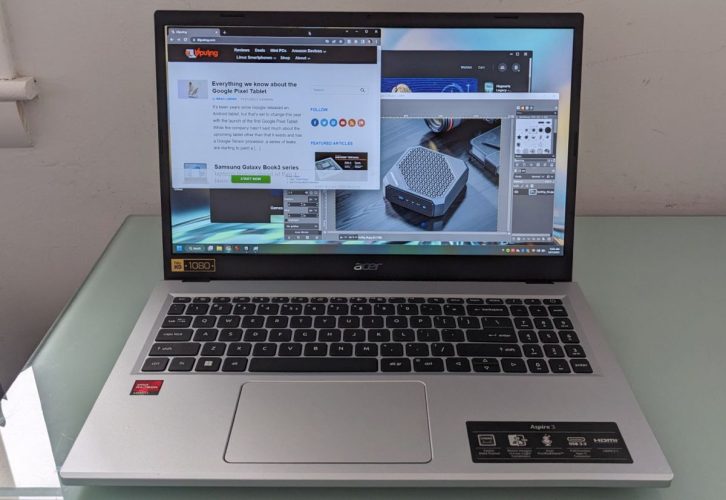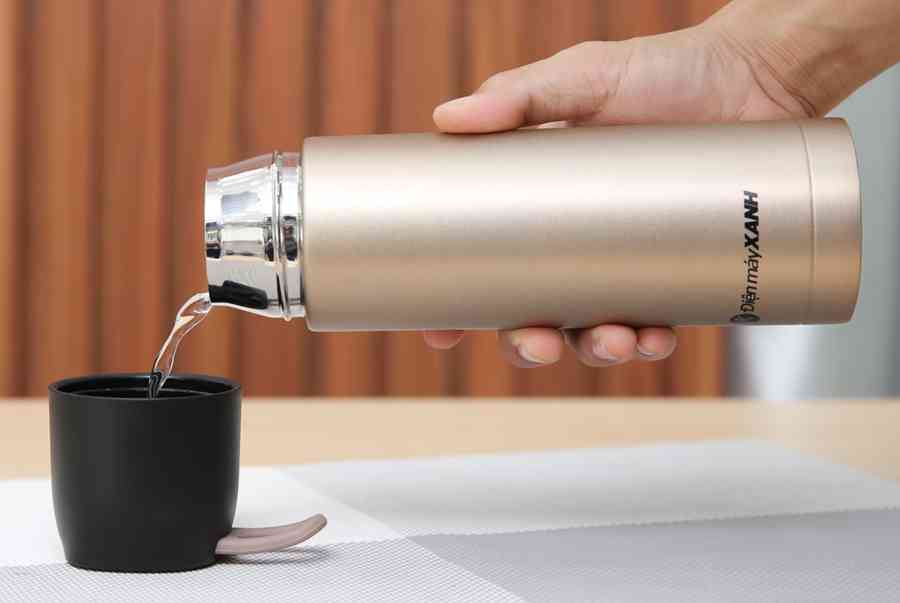Acer Aspire 3 review: An affordable laptop with an AMD “Mendocino” processor – Liliputing
The Acer Aspire 3 (A315-24P-R758B) is a budget laptop that shows you don’t need to spend an arm and a leg to get decent performance… as long as you temper your expectations. The notebook offers an interesting value proposition: pay $400 and you get a 4 pound notebook with a 15.6 inch full HD display, 8GB of LPDDR5 memory, and 128GB of storage. There’s also a $500 model with twice as much storage and a slightly faster processor.
It’s the processor that really makes this laptop unusual though. This Acer Aspire 3 is one of the first laptops to ship with an AMD Mendocino processor. This line of chips are designed to bring the sort of performance you’d expect from a mainstream notebook from a few years ago to today’s budget laptops. And for the most part it delivers. In my testing I’ve found that the Acer Aspire 3 with a Ryzen 3 7320U offers good enough all-around performance for most everyday computing tasks. But there are some limitations that make it clear this is very much a value-oriented computer.

For example, the keyboard isn’t backlit. The display doesn’t get very bright. The speakers are nothing to write home about. And the system tops out at 8GB of non-upgradeable LPDDR5 memory.
There’s also no fingerprint sensor or IR camera for biometric security, so if you want to protect your PC, you’ll have to sign in the old fashioned way with a password, PIN, or third-party security device.
And the Acer Aspire 3 has a silver plastic chassis that may look like metal from a distance, but which feels a little flimsy, especially in the keyboard area where there’s a fair amount of flex, with the plastic moving up and down a bit as you type.

But the biggest factor setting this laptop apart from pricier models is the processor. AMD’s Mendocino chips are part of the Ryzen 7000 series, but they’re designed for inexpensive laptops and other mobile devices. First unveiled in May, 2022, the processors generated a bit of buzz because of their superficial similarity to the custom AMD chip used in Valve’s Steam Deck handheld gaming PC.
That led some to hope that Mendocino chips would be perfect for low-cost gaming computers. But that’s not exactly the case. Instead, laptops like the Acer Aspire 3 offer decent all-around CPU performance, but underwhelming graphics.
That’s because while both the Steam Deck’s “Aerith” processor and AMD’s Mendocino chips combine 2019-era AMD Zen 2 CPU architecture with 2022-era RDNA 2 graphics, the Steam Deck has 8 graphics compute units and Mendocino processors have just 2. That’s good enough for 4K video playback and some light gaming or graphics work, but it’s not exactly enough to handle the latest AAA games at high graphics quality.

When Acer offered to lend me an Aspire 3 laptop to review, the main reason I said yes was because I wanted to test that brand new processor. And as I discovered when I ran some initial benchmarks, it offers CPU performance comparable to what I would have expected from a mid-range laptop from a few years ago with an AMD Ryzen 4000 series or 11th-gen Intel Core i5 processor.
Real-world usage largely mirrored those benchmarks. After installing Chrome, GIMP, Irfanview and LibreOffice on the laptop, I was able to use it as my primary work computer as I researched and wrote articles for Liliputing, and for most tasks it only felt a little slower than my Asus ROG Zephyrus G14 laptop, which I paid $1200 for and which has much more powerful hardware (including a Ryzen 9 6900HS processor, Radeon RX 6700S graphics and 16GB of RAM).
That’s partly because you don’t really need a super-powerful processor to handle many common activities like web browsing, media streaming, and light image and document editing.

But try to do anything more ambitious with this budget laptop and its hardware limitations will become a little more apparent.
It took a little longer to load some resource-intensive applications like GIMP on this laptop, for example. And opening more than a dozen web browser tabs can lead to a little lag – and sometimes I noticed web pages refreshing in the background when I switched to a tab I hadn’t used in a while, suggesting that the 8GB of RAM on this computer might not be quite enough to keep up with the tasks that the ROG Zephyrus G14 can. But overall the Acer Aspire 3 offered better performance that I’d expect from a $400 laptop.
But when it comes to graphics performance? The Acer Aspire 3 with a Ryzen 3 7320U was at the bottom of the pack in 3D graphics benchmarks. It’s very much not built for gaming.
Don’t get me wrong, you can certainly play some games on this notebook. You’ll just want to stick to titles that aren’t particularly demanding. Epistory runs beautifully on the Acer Aspire 3 laptop, for example, while graphics looked choppier when I tried playing Sable.
Other testers, including YouTuber ETA Prime, have also found that the laptop can handle emulation of some older game consoles, allowing you to play PlayStation2, GameCube, or Wii U games at resolutions up to 720p. But don’t expect the system to handle emulation of newer consoles very well.
The laptop’s Radeon 610M integrated GPU is based on AMD’s RDNA 2 architecture, but with just two GPU cores, the Aspire 3 can’t really keep up with modern, graphically intense games. The laptop does ship with an AMD Software utility that allows you to tweak some performance settings though, so you can try to eke a little more graphics performance out of the notebook by switching to the Gaming or eSports profiles.
If you’re looking for a productivity or graphics workhorse, this is clearly not the laptop for you. But it’s nice to see that a $400 laptop can handle a wide range of basic activities reasonably well.
The notebook also has a few features that are very nice to see in a notebook in this price range, including an HDMI 2.1 port, support for WiFi 6 and Bluetooth 5.2, and a full-function USB 3.2 Gen 1 Type-C port with support for DisplayPort output and USB Power Delivery.

Since that USB-C port tops out at 10 Gbps data transfer speeds, it’s not fast enough to let you connect an external graphics card or any other accessories that require higher speeds. But you can use the laptop’s ports to connect most other accessories including displays, keyboards, mice, storage, or game controllers.

And while the laptop comes with a 45W power adapter designed to fit a DC power input jack on the notebook, you can also use third-party USB-C charger with it.
The notebook has a 15.6 inch, 1920 x 1080 pixel IPS LCD non-touch display with a matte finish, which does a pretty good job of rejecting glare and looks good from most angles.

Websites, pictures, videos, and games all look pretty decent, and if you don’t like the out-of-the-box display experience, you can open the Display settings in the AMD Software utility to adjust brightness, contrast, hue, saturation, and color temperature, among other things.

One thing to note about the display is that it doesn’t get very bright at its max brightness level, so you probably aren’t going to want to use this notebook outdoors on sunny days.
Above the display is a 720p webcam, a digital microphone, and an LED light that glows green to let you know when the camera is active, which is helpful since there’s no privacy shutter or physical key to disable the camera when you’re not using it.

Picture quality from the webcam is… not great. But Acer says the laptop uses “temporal noise reduction” technology to improve performance in low-light settings, and I did notice that it did a pretty good job of keeping images bright even when I dimmed the lighting in my office (although low-light images definitely showed less detail than ones snapped in better lighting.
Without any backlighting, the laptop’s keyboard would be difficult to see in a dark room, but other than that, I have no major complaints about the keyboard.

The key travel is on the shallow side, but the key sizing, spacing, and positioning are comfortable enough that I had no trouble typing. I’m not a huge fan of the half-height up and down arrow keys, and if Acer was going to squeeze a number pad onto the right side, I would have preferred slightly wider number keys. But for a $400 laptop, the keyboard is fine.
The notebook measures 14.3″ x 9.4″ x 0.74″ and weighs 3.92 pounds, making it reasonably portable for a notebook with a 15.6 inch display. But you may want to carry a charger or a USB power bank if you’re looking for all-day computing.
The laptop has a 42 Wh battery that may get you through a full work day… but I wouldn’t count on it. I found that the battery fully discharged after 7 hours of streaming YouTube videos over WiFi with the screen brightness set to 60 percent. I’d expect that more demanding tasks will sap the battery even more quickly.

You can open up the case by removing 11 screws from the bottom of the laptop and using a prying tool to loosen the latches holding the bottom cover in place. It took a little more elbow grease than I’d anticipated, but once inside I confirmed that the laptop’s 8GB of RAM is soldered to the motherboard, which means it’s not user replaceable.
The laptop’s storage can be replaced though. The unit Acer sent me came with a 128GB Samsung PM991 PCIe Gen 3 x4 SSD plugged into an M.2 slot.
While the bottom cover is off, you can also see the heat pipe and fan that help keep the system cool. The fan can be rather noticeable under heavy load, but it stays pretty quiet when you’re watching videos or doing light web browsing.

Acer ships the laptop with Windows 11 Home software… and a lot of bloatware. Here’s some of the software that came pre-installed on the Aspire 3:
- Amazon shortcut in taskbar
- Apps Explorer
- Acer Product Registration
- Acer Care Center
- Dropbox (in taskbar)
- Evernote
- Hearts Deluxe
- MS 365 trial + Office
- MS apps ( To do, News, Photos, Sticky Notes, etc)
- Simple Mahjong
- Simple Solitaire
- Simple Spider Solitaire
- Solitaire Collection
- Spades
While a few of these programs may be useful (the Acer Care Center provides some information about your PC that may be helpful if you need to contact Acer tech support, for example), others are basically ads for products and services you may not need or want. Fortunately they can be removed or uninstalled.
And if you’d prefer to run something other than Windows, that’s also an option… although you may have to change some UEFI settings first.
In order to access the UEFI menu, press the F2 key on the keyboard during startup. Once you’ve done that, you can adjust boot device priority (to determine whether the computer should try to boot first from an external drive or internal storage) and enable an optional F12 boot menu that will let you choose which device to boot from at startup.

When I first tried booting a GNU/Linux distribution from a USB flash drive though, I was met with an error message. So I went back into the UEFI settings and noticed that it looked like the option to disable secure boot was unavailable.
But it turns out that’s not true. You just need to set a UEFI password before you have the option to disable secure boot.
Once you’ve set up your password, you can reboot, press F2 again to get to the UEFI settings, and then you can disable secure boot. FYI, at that point if you disable the need for a password, secure boot will remain disabled. But you’ll need to set up a password again if you want to re-enable secure boot.

Anyway, once I figured that out, I was able to boot Ubuntu 22.04.1 LTS from a USB flash drive and poked around long enough to discover that most hardware seems to be working. WiFi and Bluetooth, audio and video were all working, as was the webcam.

Since I didn’t install Ubuntu to local storage, I can’t comment on battery life or sleep and resume functionality. But the out-of-the-box experience looks promising.
Overall, the Acer Aspire 3 laptop with an AMD Mendocino processor offers an interesting value proposition. It’s a budget laptop with the kind of CPU performance you would have expected from a mainstream model just a few years ago.
That’s because its CPU is basically the same as what AMD was using for mainstream laptops a few years ago. And that CPU is likely to help set laptops like this apart from budget notebooks featuring the latest budget chips from Intel.

But the Acer Aspire 3 with AMD Mendocino has an underwhelming GPU, underwhelming battery life, and it’s missing some of the features you’d get if you spent just a little more money on a mid-range notebook such as backlit keyboard, fingerprint reader and/or face recognition, webcam cover, and brighter display. Support for more than 8GB of RAM would also be nice.
If you’re willing to spend a little more than $400, then you might be better off looking for a deal on a 2021 laptop with an AMD Ryzen 5 5600U or Intel Core i5-1135G7 processor instead. You’d likely get similar or better performance and some of the features this model is missing.
But it’s nice to see that AMD’s Mendocino processors are helping bring stronger performance to current-gen budget laptops like the 2023 Acer Aspire 3 family.

Also keep in mind that while the model featured in this review has an AMD Ryzen 3 7320U processor, 8GB of RAM, and 128GB of storage, Acer also offers a slightly higher-spec configuration with a Ryzen 5 7520U processor, 8GB of RAM and 256GB of storage. That model is similar in most respects, but has higher CPU base and burst speeds, which should lead to better single-core and multi-core CPU performance.
Here’s a run-down of key features for both models:
Aspire 3 AMD (7320U)Aspire 3 AMD (7520U)ModelA315-24P-R75BA315-24P-R2SCDisplay15.6 inches
1920 x 1080 pixels
60 Hz
IPS LCD
Non-touch
MatteProcessorAMD Ryzen 3 7320U
4 Zen 2 cores / 8 thread
2.4 GHz base / 4.1 GHz boost
6MB total cache
15W TDPAMD Ryzen 5 7520U
4 Zen 2 cores / 8 threads
2.8 GHz base / 4.3 GHz boost
6MB total cache
15W TDPGraphicsRadeon 610M
2 GPU cores
1.9 GHzRAM8GB
LPDDR5Storage128GB
PCIe NVMe256GB
PCIe NVMeWirelessWiFi 6
Bluetooth 5.2Ports1 x USB 3.2 Gen 1 Type-C
2 x USB USB 3.2 Gen 1 Type-A
1 x HDMII 2.1
1 x 3.5mm combo audio jackCamera720p with temporal noise reduction for low-light conditionsAudioStereo speakers
Digital microphoneBattery42 WhDimensions363 x 238 x 19mm
(14.3″ x 9.4″ x 0.7″)Weight1.8 kg
(4 pounds)Price$400$500
Support Liliputing
Liliputing’s primary sources of revenue are advertising and affiliate links (if you click the “Shop” button at the top of the page and buy something on Amazon, for example, we’ll get a small commission).
But there are several ways you can support the site directly even if you’re using an ad blocker* and hate online shopping.
Contribute to our Patreon campaign
or…
Contribute via PayPal
* If you are using an ad blocker like uBlock Origin and seeing a pop-up message at the bottom of the screen, we have a
* If you are using an ad blocker like uBlock Origin and seeing a pop-up message at the bottom of the screen, we have a guide that may help you disable it.






